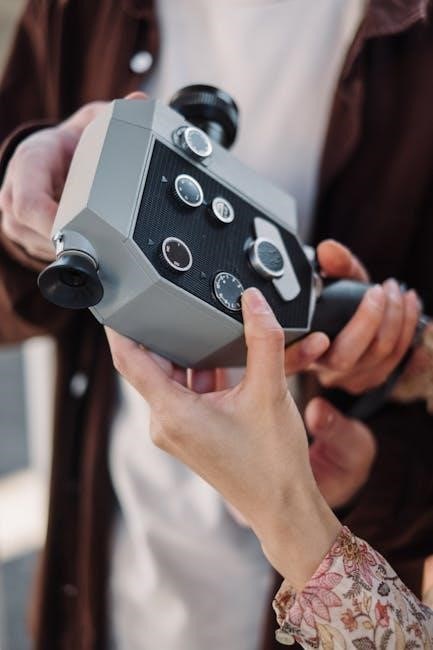Manual cell counting is an essential technique in research and diagnostics, utilizing a hemocytometer for cell enumeration under a microscope. While cost-effective, it is labor-intensive and subjective.
1.1 Overview of Manual Cell Counters
A manual cell counter, often a hemocytometer, is a specialized microscope slide with etched chambers for cell counting. It enables researchers to visually count cells in a sample, providing a cost-effective and straightforward method. The process involves loading the sample onto the slide and using a microscope to count cells within specific grids. While manual counting is accessible and low-cost, it can be time-consuming and requires skill to ensure accuracy, making it less efficient for large-scale applications.
1.2 Importance of Manual Cell Counting in Research and Diagnostics
Manual cell counting plays a crucial role in research and diagnostics, offering a reliable method for assessing cell concentration and viability. It is widely used in laboratories for quality control, drug development, and clinical diagnostics, such as complete blood counts. Despite advancements in automation, manual counting remains a valuable technique due to its simplicity, affordability, and suitability for small-scale samples. It provides essential data for understanding cellular behavior, disease diagnosis, and treatment monitoring, making it indispensable in scientific and medical settings.

What Is a Manual Cell Counter?
A manual cell counter is a tool used to enumerate cells in a sample, typically involving a hemocytometer and microscope for accurate cell counting in research and diagnostics.
2.1 Definition and Purpose
A manual cell counter is a laboratory tool used to quantify cells in a sample. Its primary purpose is to provide an accurate count of cells, essential for research and diagnostics. The device typically consists of a hemocytometer, a specialized microscope slide with chambers of known volume. By loading a cell suspension and observing under a microscope, users can manually count cells, making it a fundamental tool in biology, medicine, and related fields for monitoring cell cultures and analyzing blood components.
2.2 Key Components of a Manual Cell Counter
A manual cell counter consists of a hemocytometer, a microscope, and a counting chamber. The hemocytometer features a grid with predefined volumes, allowing precise cell enumeration. The microscope enables visualization of cells within the chamber. Other components include a coverslip to secure the sample and a dilution pipette for preparing cell suspensions. These tools collectively facilitate accurate and efficient cell counting, ensuring reliable results in various laboratory settings.
History and Evolution of Manual Cell Counting
Manual cell counting originated with early microscopic methods, evolving with the invention of hemocytometers. Advances in materials and design have improved accuracy and efficiency over time.
3.1 Early Methods of Cell Counting
Early methods of cell counting involved basic microscopic examination, where cells were visually counted; This labor-intensive process relied on manual observation and was prone to human error. The development of simple counting chambers marked the beginning of standardized techniques. These early tools laid the foundation for more precise instruments like hemocytometers, which became essential in laboratory settings. Despite limitations, these primitive methods were pivotal in establishing cell counting as a critical scientific practice.
3.2 Development of Hemocytometers
The hemocytometer was a groundbreaking innovation in cell counting, introduced to standardize and simplify the process. Its development in the 19th century revolutionized biological and medical research by providing a precise, grid-based system for counting cells under a microscope. This tool became indispensable in laboratories, enabling accurate enumeration of cells in blood and other samples. Its evolution incorporated improvements in design, such as chamber depth and grid patterns, enhancing reliability and reproducibility in cell counting procedures.

How Manual Cell Counters Work
Manual cell counters operate by placing a cell sample on a specialized slide, such as a hemocytometer, and counting cells visually under a microscope, enabling precise enumeration.
4.1 Principle of Manual Cell Counting
Manual cell counting relies on a hemocytometer, a specialized slide with a grid system, to visually count cells under a microscope. Cells are loaded into the chamber, and their number is determined by counting within specific grid squares. The method involves diluting the sample, loading it onto the slide, and using the grid’s dimensions to calculate cell concentration. This technique, while subjective, provides a direct enumeration of cells, making it a foundational tool in biological and medical sciences.
4.2 Step-by-Step Process of Manual Cell Counting
Harvest and stain cells to ensure visibility under the microscope. Clean the hemocytometer and position the coverslip. Load the cell sample into the chamber. Allow cells to settle before counting. Using a microscope, count cells in the designated grid squares, following a systematic pattern to avoid double-counting. Record the total count and calculate the cell concentration based on the volume of the chamber and dilution factor. Repeat the count to ensure accuracy.

Types of Manual Cell Counters
Manual cell counters include hemocytometers and other devices like reusable slides and photon slides, offering affordability and precision for cell counting in various settings.
5.1 Hemocytometers
A hemocytometer is a specialized microscope slide with a built-in grid, enabling precise manual cell counting. It is a standard tool in biological and medical research, designed to measure cell concentration in a sample. The grid’s dimensions allow users to count cells in a defined volume, facilitating accurate calculations. Available in types like Neubauer and Fuchs-Rosenthal, hemocytometers are cost-effective and simple to use, making them a popular choice for laboratories worldwide. However, they require skill and time for manual counting.
5.2 Other Manual Counting Devices
Beyond hemocytometers, other manual counting devices include specialized slides and chambers designed for cell enumeration. Tools like the LUNA Reusable Slide offer a cost-effective, manual counting solution with reduced variability. These devices often feature precision-engineered grids and are made from durable materials, ensuring accuracy and longevity. They are particularly useful for laboratories seeking alternatives to traditional hemocytometers, combining simplicity with reliable results. Such devices aim to enhance the efficiency of manual cell counting while maintaining affordability and ease of use.
Manual vs. Automated Cell Counters
Manual cell counters are cost-effective and straightforward but require significant time and may introduce variability. Automated counters offer speed and accuracy but involve higher costs and maintenance.
6.1 Comparison of Manual and Automated Methods
Manual cell counting, using a hemocytometer, is cost-effective and accessible but time-consuming and prone to human error. Automated counters, like the LUNA-II or DeNovix CellDrop, offer rapid, precise results with reduced variability, though they require initial investment and maintenance. Manual methods are ideal for small-scale, low-budget applications, while automated systems suit high-throughput and repetitive tasks, enhancing efficiency in research and diagnostics.
6.2 Advantages and Disadvantages of Manual Counting
Manual cell counting is cost-effective and requires minimal equipment, making it accessible for small-scale applications. However, it is time-consuming, labor-intensive, and prone to human error due to subjective interpretation. Additionally, reusable hemocytometers pose risks of contamination and require proper cleaning. Despite these drawbacks, manual counting remains a reliable option for laboratories with limited resources or for verifying automated results, provided skilled technicians perform the counts accurately.

Applications of Manual Cell Counters
Manual cell counters are widely used in research labs for cell culture monitoring and in clinical settings for blood cell analysis, ensuring accurate and reliable cell enumeration.
7.1 Research Applications
In research, manual cell counters are crucial for monitoring cell growth, viability, and concentration in cultures. They enable precise enumeration for experiments, such as proliferation assays or toxicity studies. Despite automation, manual methods remain accessible for small-scale or budget-restricted studies, offering a reliable baseline for cell quantification. Researchers often use hemocytometers for consistent results, ensuring reproducibility in scientific investigations across various biological disciplines.
7.2 Clinical and Diagnostic Applications
In clinical settings, manual cell counters are vital for diagnosing and monitoring hematological conditions. They provide accurate blood cell counts, essential for assessing patient health and guiding treatment. For example, complete blood counts help identify anemia, infections, or leukemia. Manual methods are cost-effective and reliable, especially in resource-limited settings, ensuring accessible diagnostics for healthcare professionals. Their simplicity makes them indispensable in routine clinical laboratories for quick and precise patient care.

Common Errors in Manual Cell Counting
Common errors include miscounting, calculation mistakes, and improper sample preparation. Human bias and subjective interpretation can also lead to inaccuracies, emphasizing the need for precise techniques and training.
8.1 Sources of Error
Errors in manual cell counting often stem from human subjectivity, such as inconsistent cell recognition or counting techniques. Improper calibration of the hemocytometer, contamination during sample preparation, and incorrect dilution factors can also introduce inaccuracies. Additionally, fatigue and lack of training among operators may lead to counting mistakes, emphasizing the need for standardized protocols and regular training to minimize variability and ensure reliable results.
8.2 Tips for Minimizing Errors
To minimize errors, ensure proper training and adherence to standardized protocols. Regular calibration of the hemocytometer is crucial, and samples should be prepared meticulously to avoid contamination. Counting in a consistent pattern and using a double-checking method can reduce variability. Additionally, maintaining focus and avoiding fatigue during prolonged counting sessions helps in achieving accurate results. Proper documentation and cross-verification of counts further enhance reliability and consistency in manual cell counting procedures.

Best Practices for Accurate Manual Cell Counting
Adhere to standardized protocols, ensure proper training, and maintain a clean environment to minimize contamination. Regularly calibrate equipment and use consistent techniques for reliable results.
9.1 Calibration and Maintenance
Regular calibration and maintenance of manual cell counters are crucial for accuracy. Ensure the hemocytometer is clean and free of debris. Verify the grid dimensions using a stage micrometer to confirm measurements. Properly align the coverslip to avoid air bubbles, which can distort cell counting. Schedule routine inspections and follow manufacturer guidelines to maintain optimal performance and reliability in cell enumeration processes.
9.2 Proper Technique and Training
Proper technique and training are essential for accurate manual cell counting. Ensure the hemocytometer is loaded correctly, avoiding air bubbles. Use a microscope with proper focus and magnification. Count cells systematically, following a consistent pattern to minimize errors. Training personnel on standardized protocols reduces variability; Regular practice and adherence to best practices enhance reliability and reproducibility in cell counting results.

Cost Considerations
Manual cell counters have a low initial investment and minimal maintenance costs. They are cost-effective for small-scale operations, offering long-term savings without recurring expenses for consumables.
10.1 Initial Investment
The initial cost of a manual cell counter is relatively low, making it accessible for laboratories with limited budgets. A hemocytometer, the primary tool for manual counting, is a one-time purchase, often priced affordably. This upfront expense is minimal compared to automated systems, which can be prohibitively expensive for small-scale operations. As a result, manual cell counters remain a cost-effective option for researchers and clinicians who require basic cell counting capabilities without significant financial outlay.
10.2 Long-Term Cost Savings
Manual cell counters offer substantial long-term cost savings due to their durability and minimal maintenance requirements. Unlike automated systems, they do not require expensive consumables or software updates. Over time, the low initial investment and absence of recurring costs make manual counters a financially sustainable choice. Additionally, their simplicity reduces the need for frequent repairs, further lowering overall expenditure. This makes manual cell counters a practical option for laboratories seeking to minimize long-term financial commitments while maintaining reliable cell counting capabilities.

Future Trends in Manual Cell Counting
Future trends include integrating manual counting with automated systems for enhanced accuracy and efficiency, alongside innovations in slide design and software for improved precision and user experience.
11.1 Integration with Automated Systems
Manual cell counting is increasingly being integrated with automated systems to enhance accuracy and efficiency. Automated counters like the LUNA-II and DeNovix CellDrop offer advanced image-based counting and autofocusing, reducing human error and speeding up workflows.
This integration allows researchers to leverage the simplicity of manual methods while benefiting from automation, creating a hybrid approach that maintains the accessibility of traditional techniques while incorporating cutting-edge technology for improved precision and reliability.
11.2 Innovations in Manual Counting Technology
Recent innovations in manual cell counting technology include reusable slides like PhotonSlides, which combine affordability with precision, reducing subjectivity and variability. These advancements aim to maintain the simplicity of manual methods while improving accuracy and reliability.
Additionally, improved materials and designs, such as ergonomic hemocytometers, enhance user experience, minimizing fatigue and errors. These innovations bridge the gap between traditional manual counting and modern demands for efficiency, offering cost-effective solutions for researchers and clinicians.

Case Studies and Real-World Applications
Manual cell counters are widely used in research and diagnostics, such as in microbiology labs for yeast cell counting and in medical settings for blood cell analysis.
12.1 Success Stories in Research
Manual cell counters have proven indispensable in research, enabling accurate cell enumeration in various studies. Researchers rely on them for yeast cell counting and microbiological analyses due to their affordability and accessibility. Despite advancements in automation, manual counters remain a trusted tool for small-scale experiments and educational settings, offering reliable results when used correctly. Their simplicity ensures widespread adoption in academic and laboratory environments, making them a cornerstone in cell biology research.
12.2 Practical Examples in Clinical Settings
In clinical diagnostics, manual cell counters are vital for routine blood count analyses and monitoring patient conditions. Hemocytometers are used to estimate cell concentrations, aiding in disease diagnosis and treatment monitoring. Clinicians often employ manual counting for its cost-effectiveness and simplicity, particularly in resource-limited settings. Despite automation’s rise, manual methods remain a reliable backup, ensuring accurate and timely results in healthcare facilities worldwide, thus playing a critical role in patient care and management.
Manual cell counters remain a cornerstone in research and diagnostics, balancing simplicity, affordability, and accuracy. While automation advances, their reliability ensures continued utility in various scientific and clinical settings.
13.1 Summary of Key Points
Manual cell counters are essential tools in research and diagnostics, offering a cost-effective method for cell enumeration. They rely on hemocytometers, requiring precision and skill. While labor-intensive and subjective, they provide reliable results when proper techniques are applied. Despite advancements in automation, manual counters remain vital for small-scale applications and laboratories with limited resources. Their simplicity and affordability ensure continued relevance in scientific and clinical settings, balancing tradition with practicality in cell counting processes.
13.2 Final Thoughts on the Role of Manual Cell Counters
Manual cell counters remain indispensable in research and diagnostics, offering a cost-effective and accessible method for cell enumeration. Despite the rise of automation, their simplicity and reliability make them a vital tool for small-scale applications and training. While automated counters offer speed and precision, manual counters provide a foundational understanding of cell counting techniques. Their continued relevance underscores the importance of balancing traditional methods with modern advancements in scientific and clinical settings.
